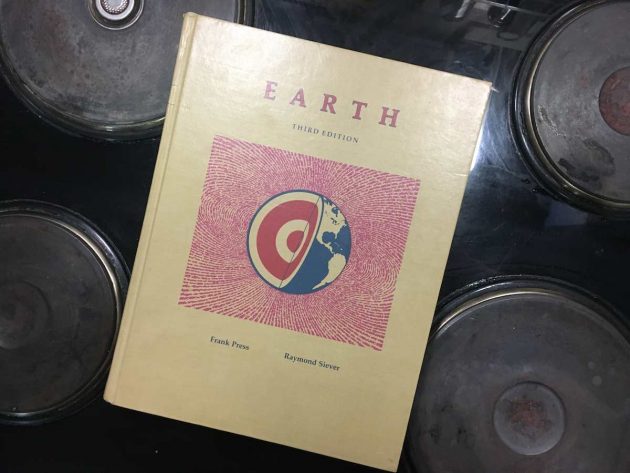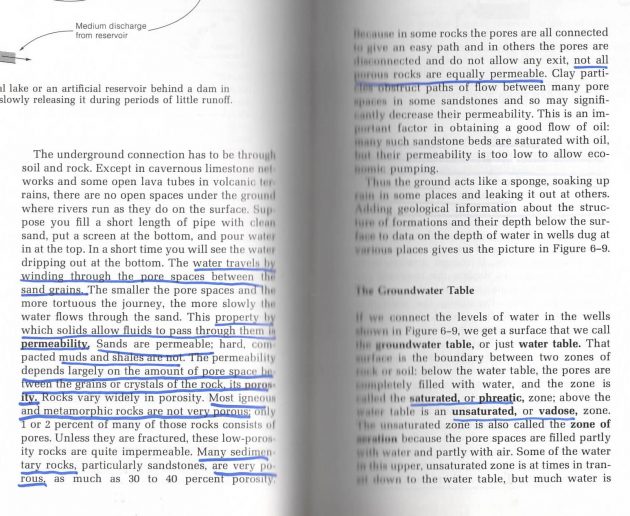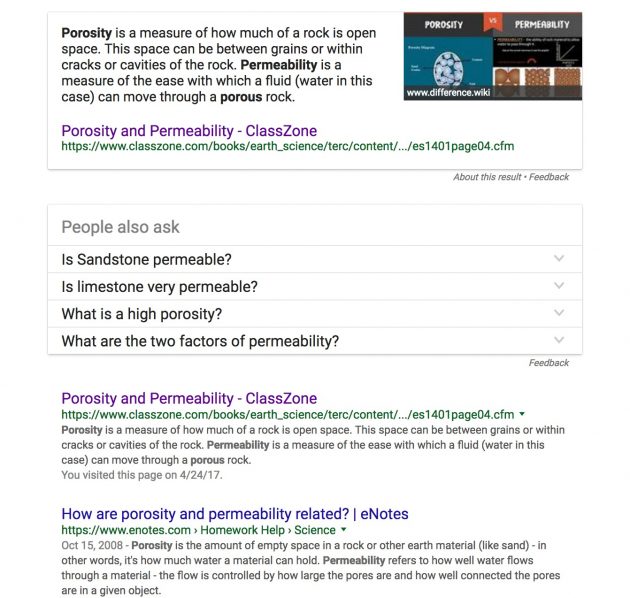OH NOES NOT DEFINITIONS!
Fear not, it’s not happening. But today during the blog-star-studded-most-of-them-self-deprecating hangout on “Open Pedagogy Open Discussion #YearOfOpen” (see the resource doc too)
Mike Caulfield made an interesting comment about openness and the metaphor of “permeability” which raises my Geology sensors (Maybe 5 years of undergraduate and 6 in graduate study of might come into play)
@holden on "permeability" & raises my Geology antennae; related to not same as porosity (~openness) ?https://t.co/28aha8qIN9 #YearOfOpen
— Alan Levine (@cogdog) April 24, 2017
I think Mike credited Alec Couros, and I recall Alec saying/writing this too. It’s funny because in trying to track this down (I did not spend enough time swimming it upstream, Mike) I find people writing about Alec using porosity and permeable interchangeably.
Because Mike deletes tweets, he makes me screenshot his reply:
I’m not that quick, Mike.
But it’s come up before, when Sheila MacNeil blogged about her porosity and even mentioned an event called The Porous University— where the opening graphic has an illustration of permeability.
My Geology is rusty, but I’m going to try and and explain some Geology basics. Permeability and Porosity are related, but not interchangeable.
As the reflexes go[oogle] Mike will appreciate how crappy the results are:
Well maybe nor so bad, the first result is rather textbooky, and in re-reading, it mostly gets it right:
Two separate characteristics of rocks control how effective they are as aquifers:
Porosity is a measure of how much of a rock is open space. This space can be between grains or within cracks or cavities of the rock.
Permeability is a measure of the ease with which a fluid (water in this case) can move through a porous rock.
This is how textbooks do it. Define it. But after reading this, can you really get to why they are or are not interchangeable?
So forget you Google. U so weak. I went into my office and pulled off what is likely my all time favorite textbook, Earth (third ed) by Frank Press and Raymond Siever, 1982

My prized possession of Earth by Press and Siever
This was the textbook I bought in maybe 1982 after my first year of studies at the University of Delaware, when I realized I did not want to be a Computer Science major (yes, irony) and I decided to try a Geology course in my sophomore year.
Press and Siever was the text. I have no idea what it cost then, I am guessing maybe $45-$60? It’s now only worth $25 new. Mine is worth even less on the resale market because it’s full of my highlights and notes.
You see, I fell so much in love with Geology that I read and marked up the entire textbook although we were assigned maybe half of it.
I digress into story.
I open Press and Siever to the index, and find porosity listed on pages 136-137 (that kids is how we searched in the old days).
Now, before I insert the next image, I am looking at the front page and it says:
No part of this book may be reproduced by any mechanical, photographic, or electronic process, or in the form of a phonographic recording, nor may it be stored in a retrieval system, transmitted, or otherwise copied for public or private use, without permission from the author
This I will use as perhaps the most complete opposite definition of “open” as one can find. I am sorely tempted to reproduce a position as a phonographic recording; instead I am going to blatantly break the copyright laws right here because they are stupid. You can tell W.H. Freeman where to find me if you want the bounty.

My illegal reproduction of a portion of 2 pages of a textbook I payed for in 1982, used here for educational purposes only.
This property by which solids allow fluids to pass through them is permeability. Sands are permeable; hard compacted muds and shales are not. The permeability depends largely on the amount of pore spaces between the grains or crystals ofthe rick, it’s porosity… Because in some rocks the pores are all connected to give an easy path and in others the pores are disconnected and do not allow any exit, not all porous rocks are equally permeable. Clay particles in some sandstones obstruct paths of flow between many pore spaces in some sandstones and so may significantly decrease their permeability.
Sands and sandstones have a lot of open space (porosity) because the ar emade of uniformly sized rounds sand grounds. Think of stacking bowling balls, and all the space in between. Clays and shales are made of parallel layers, like pages in a book, so the amount of space (porosity) is low.
But not all sandstones are made of uniformly sized materials, if they are poorly sorted, meaning a mixture of bigger and smaller grains, the space, or porosity, is lower.
So when you say porosity it really means just the volumetric measure of open space. If you want a metaphor, maybe this is measure of “openness” in terms of 5Rs.
But when you say permeability you are talking about the ease of moving something through that space, and while the amount of space is a factor, others influence whether that can happen. Specifically that could mean if the spaces are well interconnected, like pathways, like networks? Maybe that is practice or pedagogy?
Or maybe it’s just porosity and permeability.
But do me a favor, do not use these words interchangeably. I might toss a definition at you.
Featured Image: “Aquifère Darcy perméabilité” Wikimedia Commons image by Lamiot shared under CC BY-SA





Love this! I actually think i already knew the difference instinctively. If i had to make the analogy to open, i would say “porous” is how open a space is for others to ENTER (but just enter it as is) whereas permeable is how easy it is to enter THROUGH a space and connect it to other things I since you can both enter and exit, changing yourself and the space maybe along the way? I don’t know if that’s accurate. You = water, right? And I assume that some permeable rocks remain unchanged when water passes thru, others can change (i dunno how some soil becomes sand vs mud and how water affects that. But thinking of sand on the beach during tide time getting cakey). Oooh. Nice metaphor for cliques!
wonderful, Alan… thanks! there are more intersections between geology and open education than I had ever imagined 😉 this clarity is very helpful: porosity is a quality of a material/border/boundary while permeability is about ease of movement across or through that material/border/boundary. I’m sure that I have used these more loosely than this and am happy for the clarification.
I’ve just tweeted this in reply to you, but when Mike mentioned Alec’s work about thinning the walls of the classroom, Alec’s 2009 image came immediately to mind: https://www.flickr.com/photos/courosa/3327017298/in/album-72157615129270288/. Alec’s work in open teaching permeates much of our work in open education 🙂
Yes that’s the difference though it does not strictly make much difference to thinking about what enables flow. Yes the thin walls above implies at some point they are thin enough to allow flow through
Probably because of our shared links to Iceland, the first example I thought of was my first trip to Iceland in 1972 when I went swimming in a warm river near Hekla. I was told that the water was warm because the river was fed by rainwater that seeped through the volcanic rock from the lava flow from Hekla’s last eruption. I was told that this was in 19th Century but I see that Hekla has erupted more recently so perhaps that was to do with the scale and location of the eruption in relation to where I was swimming.
I am now thinking about how that might relate to the openness of learning spaces and what is flowing through the spaces. I know that Downes forbids a flow theory of knowledge:) Permeability could speed up and slow down a flow and both might be desirable in different circumstances.
This is the Alec Couros image that was in my mind last night https://www.slideshare.net/courosa/harnessing-the-power-of-social-networks-in-teaching-learning/62-Dont_limit_a_child_to
Geothermal energy is maybe a different metaphor, Frances. The heat in rivers near Hekla are not from its eruption but from the forces that caused the eruption. Everything in Iceland is influenced by it being where new magma is near the surface above a continental rift zone, like a seam opening over the liquid mantle. The house I lived in in 2008 was along the road to Hekla from Selfoss!
Either I misremembered or I was misinformed, or both. How lucky I am to have met a proper geologist 🙂 Thanks. I can’t remember what the roads were like in 1972 – not many i think. I think of Sellfoss as last shop stop before Vik.
Thank you. Structural geology was my first career; the difference between porous and permeable has been bugging me too! It’s the difference between open spaces possibly sealed off creating a closed system, and ‘networked open spaces’ forming an open system.
(Don’t get me started on the importance of the difference between stress and strain … ;-))
This is great. I read the difference as porosity being a structural feature and permeability being an attribute. And I think you’re right — this is a great metaphor for the 5Rs. Our end is permeability, which almost always involves porosity, but is not *defined* by it. I like this. I like it a lot.
On another note, you can see how my tweet deleting is working. After years of trying, I am finally getting people to make distributed copies of artifacts.